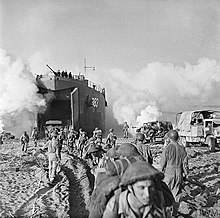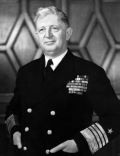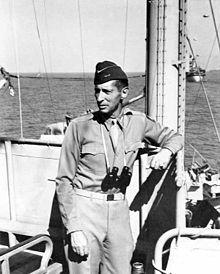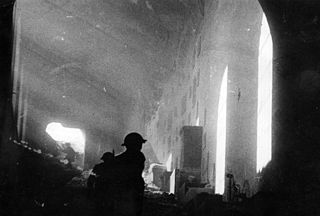
The Battle of Monte Cassino, also known as the Battle for Rome, was a series of four military assaults by the Allies against German forces in Italy during the Italian Campaign of World War II. The objective was to break through the Winter Line and facilitate an advance towards Rome.

Operation Torch was an Allied invasion of French North Africa during the Second World War. Torch was a compromise operation that met the British objective of securing victory in North Africa while allowing American armed forces the opportunity to begin their fight against Nazi Germany and Fascist Italy on a limited scale. It was the first mass involvement of US troops in the European–North African Theatre and saw the first big airborne assault carried out by the United States.
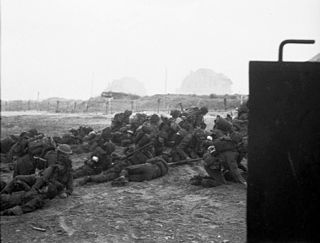
Sword, commonly known as Sword Beach, was the code name given to one of the five main landing areas along the Normandy coast during the initial assault phase, Operation Neptune, of Operation Overlord. The Allied invasion of German-occupied France commenced on 6 June 1944. Stretching 8 kilometres (5.0 mi) from Ouistreham to Saint-Aubin-sur-Mer, the beach proved to be the easternmost landing site of the invasion after the abortion of an attack on a sixth beach, code-named Band. Taking Sword was to be the responsibility of the British Army with sea transport, mine sweeping and a naval bombardment force provided by the British Royal Navy as well as elements from the Polish, Norwegian and other Allied navies.

The Battle of Anzio was a battle of the Italian Campaign of World War II that took place from January 22, 1944 to June 4, 1944. The operation was opposed by German and by Italian Repubblica Sociale Italiana (RSI) forces in the area of Anzio and Nettuno.

The Bernhardt Line, or Reinhard Line, was a German Army defensive line in Italy during the Italian Campaign of World War II. Having reached the Bernhardt Line at the start of December 1943, it took until mid-January 1944 for the US Fifth Army to fight its way to the next line of defences, the Gustav Line. The Bernhardt Line was defended by XIV Panzer Corps, part of the German Tenth Army.

GeneralfeldmarschallAlbert Kesselring was a German military officer and convicted war criminal who served in the Luftwaffe during World War II. In a career which spanned both world wars, Kesselring became one of Nazi Germany's most highly decorated commanders.

Operation Dragoon was the code name for the landing operation of the Allied invasion of Provence on 15 August 1944. Although initially designed to be executed in conjunction with Operation Overlord, the Allied landing in Normandy, a lack of available resources led to a cancellation of the second landing. By July 1944 the landing was reconsidered, as the clogged-up ports in Normandy did not have the capacity to adequately supply the Allied forces. Concurrently, the High Command of the French Liberation Army pushed for a revival of the operation that would include large numbers of French troops. As a result, the operation was finally approved in July to be executed in August.
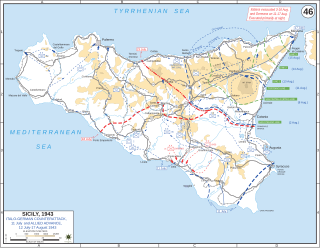
The Allied invasion of Sicily, also known as the Battle of Sicily and Operation Husky, was a major campaign of World War II in which the Allied forces invaded the island of Sicily in July 1943 and took it from the Axis powers. It began with a large amphibious and airborne operation, followed by a six-week land campaign, and initiated the Italian campaign.

The Allied invasion of Italy was the Allied amphibious landing on mainland Italy that took place from 3 September 1943, during the Italian campaign of World War II. The operation was undertaken by General Sir Harold Alexander's 15th Army Group and followed the successful Allied invasion of Sicily. The main invasion force landed on the west coast of Italy at Salerno on September 9 as part of Operation Avalanche, while two supporting operations took place in Calabria and Taranto.

Operation Baytown was an Allied amphibious landing on the mainland of Italy that took place on 3 September 1943, part of the Allied invasion of Italy, itself part of the Italian Campaign, during the Second World War.

Operation Slapstick was the code name for a British landing from the sea at the Italian port of Taranto during the Second World War. The operation, one of three landings during the Allied invasion of Italy in September 1943, was undertaken by airborne troops of the British 1st Airborne Division, commanded by Major-General George Hopkinson.

The Italian campaign of World War II, also called the Liberation of Italy following the German occupation in September 1943, consisted of Allied and Axis operations in and around Italy, from 1943 to 1945. The joint Allied Forces Headquarters (AFHQ) was operationally responsible for all Allied land forces in the Mediterranean theatre and it planned and led the invasion of Sicily in July 1943, followed in September by the invasion of the Italian mainland and the campaign in Italy until the surrender of the German Armed Forces in Italy in May 1945.

The VI Corps was activated as VI Army Corps in August 1918 at Neufchâteau, France, serving in the Lorraine Campaign. Constituted in the Organized Reserves in 1921, it was allotted to the Regular Army in 1933 and activated on 1 August 1940 at Fort Sheridan, Illinois. VI Corps took part in some of the most high-profile operations in World War II.

The Gothic Line was a German and Italian defensive line of the Italian Campaign of World War II. It formed Field Marshal Albert Kesselring's last major line of defence along the summits of the northern part of the Apennine Mountains during the fighting retreat of the German forces in Italy against the Allied Armies in Italy, commanded by General Sir Harold Alexander.

The 44th Infantry Division was formed on 1 April 1938 in Vienna, about two weeks after the Anschluss of Austria. It first saw combat at the start of the war in the Invasion of Poland, and also took part in the Battle of France in 1940. After a 9-month period of coastal defence the division was transferred East. On 22 June 1941, the division took part in the invasion of the Soviet Union, attached to Army Group South. It remained in the east after the failure of "Operation Barbarossa", taking part in defensive actions for the winter against the Soviet Army offensives near Izum and Kharkov. Refurbished, the division participated in the German summer offensive, and was subsequently destroyed with the 6th Army at Stalingrad in January 1943.

The Battle of the Argenta Gap was an engagement which formed part of the Allied spring 1945 offensive during the Italian campaign in the final stages of the Second World War. It took place in northern Italy from 12 to 19 April 1945 between troops of British V Corps commanded by Lieutenant-General Charles Keightley and German units of LXXVI Panzer Corps commanded by Lieutenant General Gerhard von Schwerin.

The Battle of San Pietro Infine was a major engagement from 8–17 December 1943, in the Italian Campaign of World War II involving Allied forces attacking from the south against heavily fortified positions of the German "Winter Line" in and around the town of San Pietro Infine, just south of Monte Cassino about halfway between Naples and Rome.

Operation Achse, originally called Operation Alaric, was the codename for the German operation to forcibly disarm the Italian armed forces after Italy's armistice with the Allies on 3 September 1943.
The Allied invasion of Italy, a phase of the Mediterranean Theater of World War II, took place on 3 September at Reggio di Calabria, and on 9 September 1943 at Taranto and Salerno. Allied naval forces landed American and Commonwealth troops on the beaches of southern Italy where they faced resistance from Axis forces.
The I Fallschirmkorps was one of the main German Luftwaffe Corps during World War II.
